最新中西饮食文化的不同(英文)
- 格式:ppt
- 大小:3.55 MB
- 文档页数:7
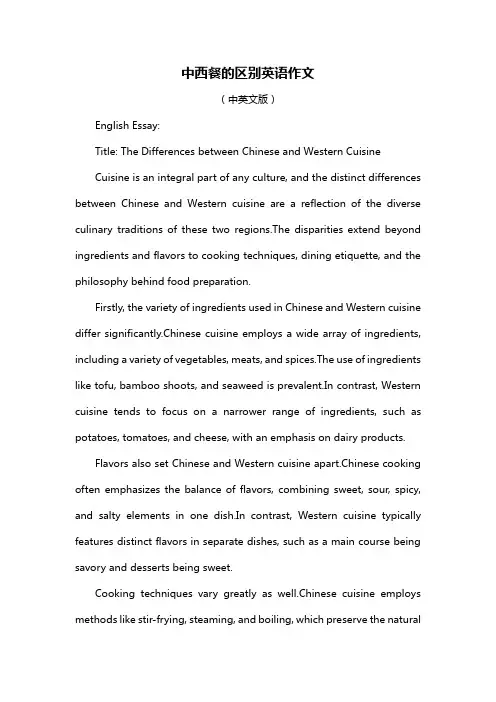
中西餐的区别英语作文(中英文版)English Essay:Title: The Differences between Chinese and Western CuisineCuisine is an integral part of any culture, and the distinct differences between Chinese and Western cuisine are a reflection of the diverse culinary traditions of these two regions.The disparities extend beyond ingredients and flavors to cooking techniques, dining etiquette, and the philosophy behind food preparation.Firstly, the variety of ingredients used in Chinese and Western cuisine differ significantly.Chinese cuisine employs a wide array of ingredients, including a variety of vegetables, meats, and spices.The use of ingredients like tofu, bamboo shoots, and seaweed is prevalent.In contrast, Western cuisine tends to focus on a narrower range of ingredients, such as potatoes, tomatoes, and cheese, with an emphasis on dairy products.Flavors also set Chinese and Western cuisine apart.Chinese cooking often emphasizes the balance of flavors, combining sweet, sour, spicy, and salty elements in one dish.In contrast, Western cuisine typically features distinct flavors in separate dishes, such as a main course being savory and desserts being sweet.Cooking techniques vary greatly as well.Chinese cuisine employs methods like stir-frying, steaming, and boiling, which preserve the naturalflavors and textures of the ingredients.On the other hand, Western cuisine frequently uses techniques like roasting, baking, and grilling, which often result in a more substantial and robust taste.Dining etiquette reflects cultural differences too.Chinese meals are communal affairs, with dishes being shared and placed at the center of the table.Chopsticks are the primary eating utensil, promoting interaction and a sense of community.In contrast, Western meals are more individualistic, with each person having their own portion and eating with a fork, knife, and sometimes a spoon.Lastly, the philosophy behind food preparation differs between the two cuisines.Chinese cuisine is deeply rooted in the principles of balance and harmony, with an emphasis on the health benefits of food.The concept of yin and yang is often applied, where certain ingredients are believed to have healing properties.Western cuisine, while also considering health aspects, tends to focus more on the presentation and creativity of dishes, often influenced by culinary trends and individual expression.In conclusion, the differences between Chinese and Western cuisine are multifaceted, encompassing ingredients, flavors, cooking techniques, dining etiquette, and the philosophy behind food preparation.These distinctions not only make each cuisine unique but also offer a fascinating window into the diverse culinary heritages of the world.中文作文:标题:中西方饮食的差异饮食是任何文化中不可或缺的一部分,中西方饮食之间的显著差异反映了这两个地区多样的烹饪传统。
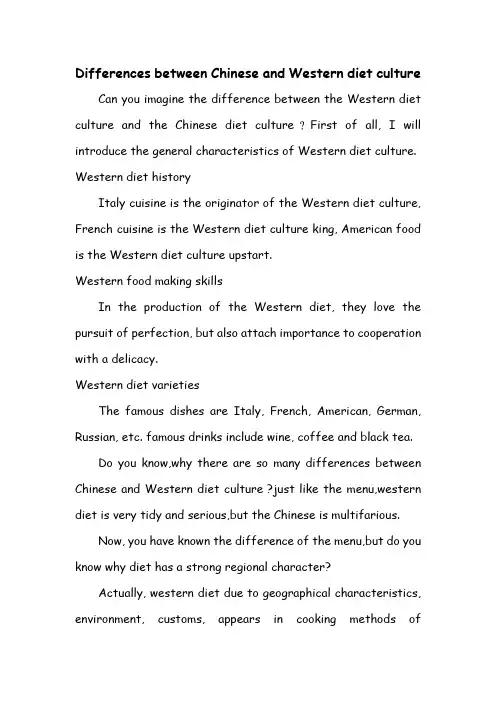
Differences between Chinese and Western diet culture Can you imagine the difference between the Western diet culture and the Chinese diet culture?First of all, I will introduce the general characteristics of Western diet culture. Western diet historyItaly cuisine is the originator of the Western diet culture, French cuisine is the Western diet culture king, American food is the Western diet culture upstart.Western food making skillsIn the production of the Western diet, they love the pursuit of perfection, but also attach importance to cooperation with a delicacy.Western diet varietiesThe famous dishes are Italy, French, American, German, Russian, etc. famous drinks include wine, coffee and black tea.Do you know,why there are so many differences between Chinese and Western diet culture ?just like the menu,western diet is very tidy and serious,but the Chinese is multifarious.Now, you have known the difference of the menu,but do you know why diet has a strong regional character?Actually, western diet due to geographical characteristics, environment, customs, appears in cooking methods ofdifferences in eating habits. People in western countries like to eat pizza, while Chinese people like to eat dumplings.Differences between Chinese and Western culture makes a difference of Chinese and Western food culture.事实上,西方饮食由于地域特色、环境、风俗习惯,出现烹调方法不同程度的差异。
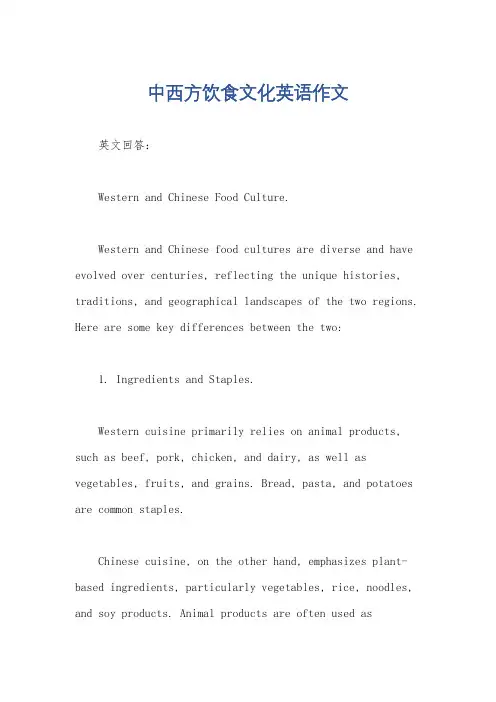
中西方饮食文化英语作文英文回答:Western and Chinese Food Culture.Western and Chinese food cultures are diverse and have evolved over centuries, reflecting the unique histories, traditions, and geographical landscapes of the two regions. Here are some key differences between the two:1. Ingredients and Staples.Western cuisine primarily relies on animal products, such as beef, pork, chicken, and dairy, as well as vegetables, fruits, and grains. Bread, pasta, and potatoes are common staples.Chinese cuisine, on the other hand, emphasizes plant-based ingredients, particularly vegetables, rice, noodles, and soy products. Animal products are often used ascomplements or flavorings rather than the main components of dishes.2. Cooking Methods.Western cooking methods include grilling, roasting, frying, and baking, which emphasize the natural flavors of the ingredients. Seasonings are typically used sparingly.Chinese cooking techniques are more varied and include stir-frying, steaming, braising, and deep-frying. Chinese cuisine places a strong emphasis on balancing flavors and textures, using a wide range of seasonings and sauces.3. Presentation.Western food presentations often prioritize aesthetics and individual portions. Dishes are typically served on plates with separate compartments for different items.In Chinese cuisine, dishes are often served communally on large plates or platters. The communal aspect reflectsthe importance of sharing and family in Chinese culture.4. Dining Customs.Western dining customs are influenced by etiquette and formality. Meals are typically served in courses, with specific utensils assigned for each item. Guests are expected to follow certain table manners and conversation rules.Chinese dining customs are more relaxed and social. Chopsticks are used to eat most meals, and dishes are shared among guests. Conversation and laughter are encouraged during meals.5. Meal Structure.Western meals typically consist of three main courses: breakfast, lunch, and dinner. Dinner is often the largest and most formal meal of the day.Chinese meals often involve smaller, more frequentportions throughout the day. Breakfast and lunch are typically lighter, while dinner is a more substantial meal. Snacks and dim sum are also popular in Chinese cuisine.6. Cultural Influences.Western food culture has been influenced by a variety of other cultures, including Mediterranean, Middle Eastern, and Asian cuisines. This has resulted in a diverse range of dishes and flavors.Chinese food culture has also been influenced by other Asian cuisines, such as Japanese and Korean, as well as by its own regional variations.中文回答:西方饮食文化和中国饮食文化。
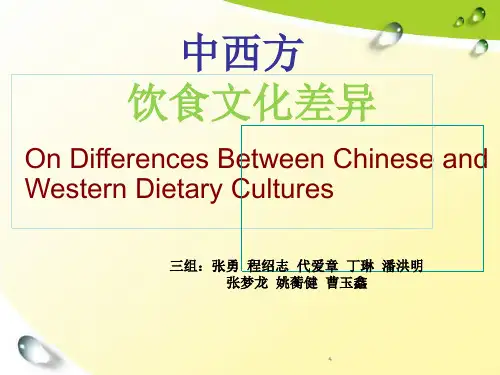

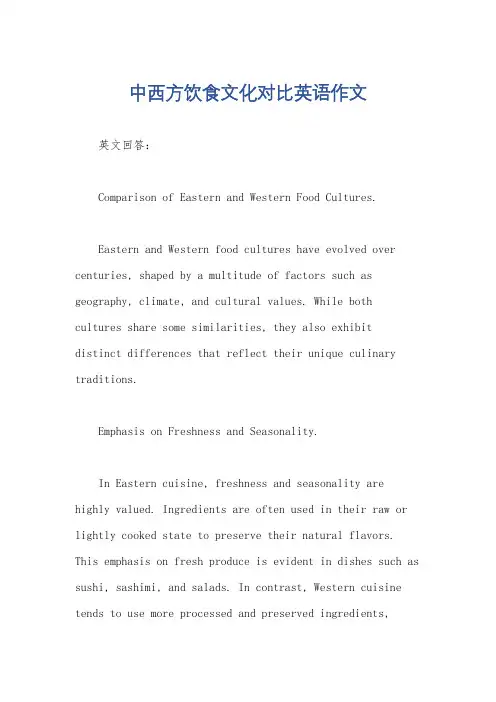
中西方饮食文化对比英语作文英文回答:Comparison of Eastern and Western Food Cultures.Eastern and Western food cultures have evolved over centuries, shaped by a multitude of factors such as geography, climate, and cultural values. While bothcultures share some similarities, they also exhibitdistinct differences that reflect their unique culinary traditions.Emphasis on Freshness and Seasonality.In Eastern cuisine, freshness and seasonality are highly valued. Ingredients are often used in their raw or lightly cooked state to preserve their natural flavors. This emphasis on fresh produce is evident in dishes such as sushi, sashimi, and salads. In contrast, Western cuisine tends to use more processed and preserved ingredients,allowing for greater flexibility in preparation and storage.Balance and Harmony.Eastern cuisine is characterized by a focus on balance and harmony. Dishes often combine a variety of flavors and textures, such as sweet, sour, salty, and bitter. This balance is achieved through the careful selection and combination of ingredients, as well as the use of cooking techniques that preserve the natural flavors of each ingredient. Western cuisine, on the other hand, often emphasizes a single dominant flavor, such as saltiness or sweetness, and may use more intense seasonings and sauces.Communal Dining.In Eastern cultures, dining is often a communal experience, with meals shared among family and friends. Dishes are typically served in large portions and placed in the center of the table, allowing everyone to partake. This communal aspect fosters a sense of togetherness and sharing. Western cuisine, while not always communal, often involvessmaller portion sizes and individual plates, reflecting a more individualized approach to dining.Influence of Religion.Religion has played a significant role in shaping both Eastern and Western food cultures. In the East, Buddhismand Taoism have influenced the development of vegetarianand vegan diets. Hinduism has also introduced a wide rangeof spices and herbs to Indian cuisine. In the West, Christianity has influenced fasting practices and dietary restrictions during Lent and other religious holidays.Availability of Ingredients.The availability of ingredients has also shaped the development of Eastern and Western food cultures. Eastern cuisine has long been influenced by the abundance of rice, vegetables, and seafood in Asia. Western cuisine, on the other hand, has historically relied on wheat, meat, anddairy products, which were more readily available in Europe.Impact of Globalization.Globalization has led to increased interaction and exchange between Eastern and Western food cultures. Ingredients, dishes, and culinary techniques from both cultures have become more widely available and incorporated into new and innovative cuisines. This has contributed to a greater appreciation and understanding of both Eastern and Western culinary traditions.中文回答:东西方饮食文化对比。
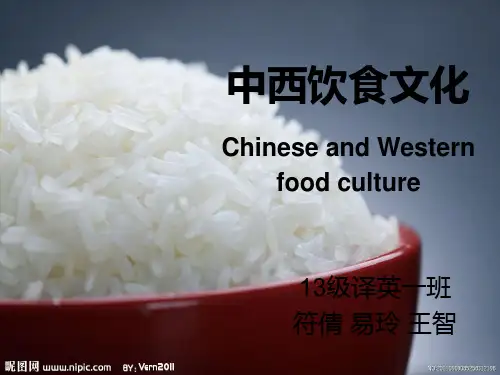
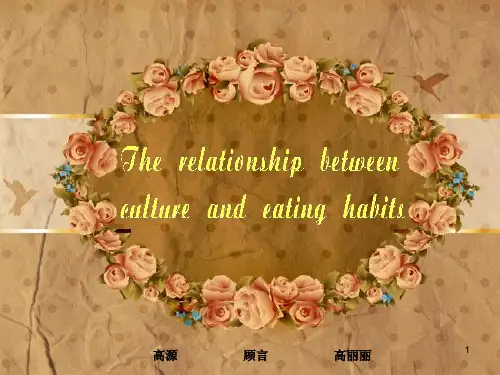
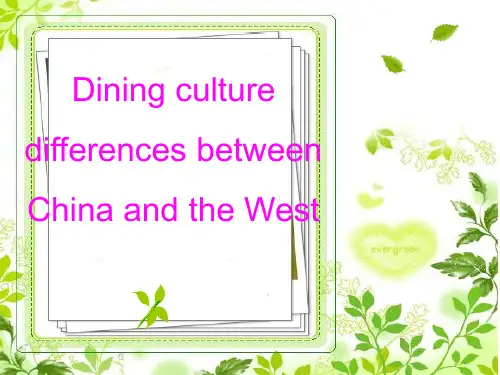
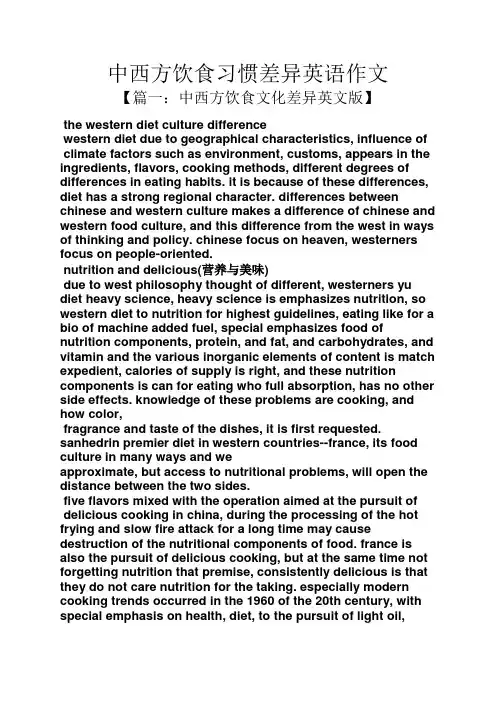
中西方饮食习惯差异英语作文【篇一:中西方饮食文化差异英文版】the western diet culture differencewestern diet due to geographical characteristics, influence of climate factors such as environment, customs, appears in the ingredients, flavors, cooking methods, different degrees of differences in eating habits. it is because of these differences, diet has a strong regional character. differences between chinese and western culture makes a difference of chinese and western food culture, and this difference from the west in ways of thinking and policy. chinese focus on heaven, westerners focus on people-oriented.nutrition and delicious(营养与美味)due to west philosophy thought of different, westerners yu diet heavy science, heavy science is emphasizes nutrition, so western diet to nutrition for highest guidelines, eating like for a bio of machine added fuel, special emphasizes food of nutrition components, protein, and fat, and carbohydrates, and vitamin and the various inorganic elements of content is match expedient, calories of supply is right, and these nutrition components is can for eating who full absorption, has no other side effects. knowledge of these problems are cooking, and how color,fragrance and taste of the dishes, it is first requested. sanhedrin premier diet in western countries--france, its food culture in many ways and weapproximate, but access to nutritional problems, will open the distance between the two sides.five flavors mixed with the operation aimed at the pursuit ofdelicious cooking in china, during the processing of the hot frying and slow fire attack for a long time may cause destruction of the nutritional components of food. france is also the pursuit of delicious cooking, but at the same time not forgetting nutrition that premise, consistently delicious is that they do not care nutrition for the taking. especially modern cooking trends occurred in the 1960 of the 20th century, with special emphasis on health, diet, to the pursuit of light oil,emphasized the use of fresh raw materials, stressed during the cooking process tomaintain original nutrition and taste, so vegetables are eaten raw. so that the western diet nutrition is universal。
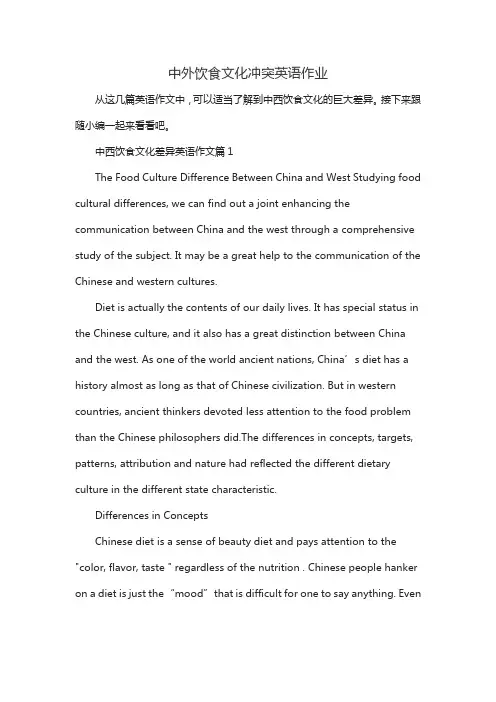
中外饮食文化冲突英语作业从这几篇英语作文中,可以适当了解到中西饮食文化的巨大差异。
接下来跟随小编一起来看看吧。
中西饮食文化差异英语作文篇1The Food Culture Difference Between China and West Studying food cultural differences, we can find out a joint enhancing the communication between China and the west through a comprehensive study of the subject. It may be a great help to the communication of the Chinese and western cultures.Diet is actually the contents of our daily lives. It has special status in the Chinese culture, and it also has a great distinction between China and the west. As one of the world ancient nations, China’s diet has a history almost as long as that of Chinese civilization. But in western countries, ancient thinkers devoted less attention to the food problem than the Chinese philosophers did.The differences in concepts, targets, patterns, attribution and nature had reflected the different dietary culture in the different state characteristic.Differences in ConceptsChinese diet is a sense of beauty diet and pays attention to the "color, flavor, taste " regardless of the nutrition . Chinese people hanker on a diet is just the “mood”that is difficult for one to say anything. Evenusing the "color, flavor, shape and implement "which people often said to make the" realm "reification, is still difficult to crown all.中西饮食文化差异英语作文篇2The major differences of eating culture between the West and Chinaa.The use of tablewareAs we all know, chopsticks is our traditional tableware. We use chopsticks and spoon mostly and cups,plates,bowls and saucers are essential.The western use knife and fork.to eat..Their knifes can be divided into consumption knife, meat knife, friet knife, butter knife, fish knife and so on. The also have many kinds of forks like consumption fork, fish fork, and lobster fork.b.The way to cookChina has very rich kind of cooking methods, such as braising, quick boiling, scaling, stewing, gradual simmering, slow red cooking, steaming, decoction and so on, up to more than thirty kinds. Besides, the dishes cooked with these methods are numerous. That is why Chinese feel it is very interesting to cook, while the Westerners emphasize too much on scientific diet and the collocation of nutrition. They cook according to scientific disciplines all the time, which is mechanized and monotonous, therefore without any joy.c.The order of saving dishesIn a Chinese banquet cold dishes are the first served, next the hot dishes and the main course come with the following of soup, then follows the main food or desserts. Fruits often come the last. In a western banquet the serving order is different. The first course of Western dinner is appetizer. Appetizers have specific flavors, mainly salty or sour. They are few in amount but high in qualities. Different from Chinese dinners, the second course of Western dinner is soup. Western soup can be divided into four kinds, clear soup, cream soup, vegetable soup and cool soup which can be divided into more kinds. The third course of a Western dinner is non-stable dish. Usually, aquatic products, eggs, bread is called non-stable dish. The fourth course of Western dinner is the main course, which contains meat and bird species. The fifth course of Western dinner is dishes made of vegetables. Westerners often eat raw vegetables, so vegetables are often made into salad. The six course of Western dinner is dessert, such as pudding, pancakes, ice cream, cheese and fruits. The last course contains beverage, coffee or tea.中西饮食文化差异英语作文篇3The Western diet culture differenceWestern diet due to geographical characteristics, influence ofclimate factors such as environment, customs, appears in the ingredients, flavors, cooking methods, different degrees of differences in eating habits. It is because of these differences, diet has a strong regionalcharacter. Differences between Chinese and Western culture makes a difference of Chinese and Western food culture, and this difference from the West in ways of thinking and policy. Chinese focus on "Heaven", Westerners focus on "people-oriented".Nutrition and delicious(营养与美味)Due to West philosophy thought of different, Westerners Yu diet heavy science, heavy science is emphasizes nutrition, so Western diet to nutrition for highest guidelines, eating like for a bio of machine added fuel, special emphasizes food of nutrition components, protein, and fat, and carbohydrates, and vitamin and the various inorganic elements of content is match expedient, calories of supply is right, and these nutrition components is can for eating who full absorption, has no other side effects. Knowledge of these problems are cooking, and how color, fragrance and taste of the dishes, it is first requested. Sanhedrin Premier diet in Western countries--France, its food culture in many ways and weapproximate, but access to nutritional problems, will open the distance between the two sides.Five flavors mixed with the operation aimed at the pursuit of delicious cooking in China, during the processing of the hot frying and slow fire attack for a long time may cause destruction of the nutritional components of food. France is also the pursuit of delicious cooking, butat the same time not forgetting "nutrition" that premise, consistently delicious is that they do not care nutrition for the taking. Especially modern cooking trends occurred in the 1960 of the 20th century, with special emphasis on health, diet, to the pursuit of light oil, emphasized the use of fresh raw materials, stressed during the cooking process to maintain original nutrition and taste, so vegetables are eaten raw. So that the Western diet nutrition is universal。
Next, I will talk about the Differences between Chinese and Western diet Culture. First, Chinese use chopsticks and soup spoons. We use the bowls as the container of rice. While the Western use knifves and folks.They use plates as containers of food and eat food as soon as they cut them.Second, We have different eating habits. Chinese have a saying “Good things for breakfast. Eating a big meal for lunch but eating less at dinner.” Many Americans agree that one should start the day with a good breakfast, but their ideas about lunch and dinner are different.Most Americans only give themselves a short time for lunch. So they eat a small lunch. After work they will have more time to eat a big dinner.Since the differences between Chinese and western philosophy, the concept of diet is quite different. People in western countries pay much attention on the nutrients. They care about how many calories, vitamins and protein should be taken. Even when the taste is the same, it must be eaten because of the nutrition.On the contrary, Chinese cares more about food color, smell, taste, and shape.For table manners,Chinese people prefer to toast each other and urge others to drink more in a lively atmosphere. Very often you can hear people talking and laughing loudly, and they are just having a good time. In America it is not like this. They want a quiet place where they can enjoy a good meal. If someone is talking too loudly, the manager of the restaurant may come out and ask them to be quiet.Finally, let’s talk about two details of the differences. First of all, the making method of Chinese food is different from Western-style food. In a Western-style food cookbook, various ingredients have been indicated several grams, several spoons or several cups, even the size of the egg will all be explained. I think it is like doing experiments in the laboratory. So, Making Western-style food is easy, so long as you cook according to the cookbook manual. But it is not an easy thing that you want to make fine Chinese food. Even if you have bought the cookbook. Because the Chinese cookbook will not tell you several grams of ingredient, for example salt, Chinese cookbook just tell you appropriate amount of salt. Why? Because the taste of people who live in different places is diff erent in China. There is a folk adage in China “south sweet, north salty, east hot and west sour”. So, a good cook ing relies on experience and skills when cooks in China.The way that Chinese and occidental praise food is different. When praising food Chi nese will generally say: “Your dish is cooked excellently, It has caught up with the level of the restaurant”; but occidental will say it just like what the home make. Then welcome my partner Zhao Bing to tell you the causes of the differences and make a conclusion.。
Differences between Chinese and Western diet culture Can you imagine the difference between the Western diet culture and the Chinese diet culture?First of all, I will introduce the general characteristics of Western diet culture. Western diet historyItaly cuisine is the originator of the Western diet culture, French cuisine is the Western diet culture king, American food is the Western diet culture upstart.Western food making skillsIn the production of the Western diet, they love the pursuit of perfection, but also attach importance to cooperation with a delicacy.Western diet varietiesThe famous dishes are Italy, French, American, German, Russian, etc. famous drinks include wine, coffee and black tea.Do you know,why there are so many differences between Chinese and Western diet culture ?just like the menu,western diet is very tidy and serious,but the Chinese is multifarious.Now, you have known the difference of the menu,but do you know why diet has a strong regional character?Actually, western diet due to geographical characteristics, environment, customs, appears in cooking methods ofdifferences in eating habits. People in western countries like to eat pizza, while Chinese people like to eat dumplings.Differences between Chinese and Western culture makes a difference of Chinese and Western food culture.事实上,西方饮食由于地域特色、环境、风俗习惯,出现烹调方法不同程度的差异。
餐饮产品由于地域特征、气侯环境、风俗习惯等因素的影响,会出现在原料、口味、烹调方法、饮食习惯上的不同程度的差异。
正是因为这些差异,餐饮产品具有了强烈的地域性。
中西文化之间的差异造就了中西饮食文化的差异,而这种差异来自中西方不同的思维方式和处世哲学。
中国人注重“天人合一”,西方人注重“以人为本”。
这里简要从下面三个方面谈谈中西方饮食文化的差异。
The dining product as a result of factor and so on region characteristic, climatic environment, manners and customs influences, will appear in raw material, the taste, the cooking method, the food habit varying degree difference. Was precisely because of these differences, the dining product had the intense localization. Between China and the West culture's difference has accomplished China and the West diet culture difference, but this kind of difference and gets along with people the philosophy from the West different thinking mode. The Chinese pays great attention “the beauty to uni te”, the westerner pays great attention “humanist”. here chats the Western diet culture difference briefly from the following three aspects. 第二种翻译:Food products due to geographical features, climate, customs, and other factors, will appear in the raw materials, food, cooking methods, dietary habits on the varying degrees of difference. It is precisely because of these differences in food products with a strong regional. The difference between Chinese and Western cultures to create a diet of Chinese and Western cultural differences, and differences from the West in a different way of thinking and philosophy of life. Chinese people pay attention to the "Heaven and Man," in the West focus on "people-oriented."From here, a brief talk about the following three areas in the Western diet and cultural differences.一、两种不同的饮食观念对比注重“味”的中国饮食,西方是一种理性饮食观念。